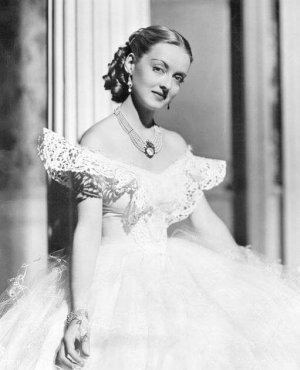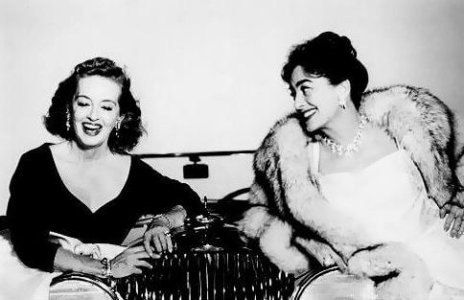Cinema icons Joan Crawford and Bette Davis: The truth behind their famous feud
- Replies 5
They say that life imitates art, and nowhere is that truer than in Hollywood. The movie capital of the world has always been a breeding ground for drama, gossip, and scandals – both on-screen and off.
And few feuds in Tinseltown history are as famous (or as long-running) as the one between two of cinema's most legendary actresses: Joan Crawford and Bette Davis.
The old rivalry between these two warring icons truly did span decades, with each woman scoring some major points against the other along the way. But how did it all begin?
It all started in 1930, when Joan Crawford, already an established actress, felt ‘threatened’ by a rising new star, then 22-year-old Bette Davis.
Bette had just signed on to join the comedy film, Ex-Lady, the first film that would feature her name above the title. Warner Bros. planned an elaborate publicity campaign to help catapult Bette’s name in the industry – that was until Joan announced that she was divorcing her first husband, Douglas Fairbanks Jr., on the same day.
The announcement became the headline for every newspaper covering entertainment news at the time. Joan and Douglas shared one of the greatest love affairs during the 1930s, and many in Hollywood at the time followed their relationship religiously.
This shocking revelation prompted The New York Times to downsize Bette’s film debut from a headline to a tiny paragraph and instead made more space to report on the Crawford-Fairbanks Jr. divorce.
Other papers followed suit, and Ex-Lady was dropped from theatres a few weeks after due to poor ticket sales. Thus, the feuding began.
In an interview with journalist Michael Thornton, Bette said that she has never forgiven Joan for what she did. ‘I never will,’ she shared.
Years later, in 1935, the women’s rivalry hit a new high when their love lives became entangled.
Bette had just starred in the drama, Dangerous, and fell head-over-heels for her handsome co-star Franchot Tone. ‘I fell in love with Franchot, professionally and privately. Everything about him reflected his elegance, from his name to his manners,’ said Bette.
However, Joan got to Franchot first, and the couple announced their engagement during the filming of Dangerous. In a separate interview, Bette shared that Franchot was ‘madly in love’ with Joan.
‘They met each day for lunch. He would return to the set, his face covered in lipstick. He was honoured that this great star was in love with him. I was jealous, of course.’
Joan revealed that her fiancé thought Bette was a ‘good actress, but he never thought of her as a woman’. That was a little catty, don’t you think?
‘She took him from me,’ Bette said. ‘She did it coldly, deliberately, and with complete ruthlessness,’ she continued.
In 1936, their feud continued well into the Oscars ceremony. Bette was nominated for the Best Actress award for her performance in Dangerous, but wasn’t sure if she would win and so she dressed plainly.
But she won, and it was said that Franchot got up to embrace Bette, but Joan kept her back turned to Bette. Franchot called out his now-wife for being rude, and Joan (allegedly) turned to Bette and said: ‘Dear Bette! What a lovely frock!’ Imagine the headlines if this happened today, folks.
Fast forward to 1962, when the pair appeared in their first and only film together, Whatever Happened to Baby Jane?
It was said that during the filming, many tense and awkward moments took place. Allegedly, Joan requested a body double because she ‘did not trust’ Bette not to hurt her in real life in one of their scenes.
Rumours also said that Bette enacted revenge by filling her pockets with rocks to make it more difficult for Joan to drag her across the room in another scene.
Despite the alleged antics, the film was a surprise box office hit and catapulted both women to stardom again.
Their famous rivalry came to an end when Joan passed away due to a heart attack in 1977. When this happened, some believe that Bette had this to say:
‘You should never say bad things about the dead. You should only say good.’
Then she followed it up with:
‘Joan Crawford is dead. Good.’ Though the quote remains unverified, this is quite the ‘icing on the cake’ of their decades-long fight, don’t you think?
A summarised version of their feud can be found below:

Do you believe that there was even a rivalry to begin with or was it just a series of (unfortunate) coincidences? Let us know in the comments!
And few feuds in Tinseltown history are as famous (or as long-running) as the one between two of cinema's most legendary actresses: Joan Crawford and Bette Davis.
The old rivalry between these two warring icons truly did span decades, with each woman scoring some major points against the other along the way. But how did it all begin?
It all started in 1930, when Joan Crawford, already an established actress, felt ‘threatened’ by a rising new star, then 22-year-old Bette Davis.
Bette had just signed on to join the comedy film, Ex-Lady, the first film that would feature her name above the title. Warner Bros. planned an elaborate publicity campaign to help catapult Bette’s name in the industry – that was until Joan announced that she was divorcing her first husband, Douglas Fairbanks Jr., on the same day.
The announcement became the headline for every newspaper covering entertainment news at the time. Joan and Douglas shared one of the greatest love affairs during the 1930s, and many in Hollywood at the time followed their relationship religiously.
This shocking revelation prompted The New York Times to downsize Bette’s film debut from a headline to a tiny paragraph and instead made more space to report on the Crawford-Fairbanks Jr. divorce.
Other papers followed suit, and Ex-Lady was dropped from theatres a few weeks after due to poor ticket sales. Thus, the feuding began.
In an interview with journalist Michael Thornton, Bette said that she has never forgiven Joan for what she did. ‘I never will,’ she shared.
Years later, in 1935, the women’s rivalry hit a new high when their love lives became entangled.
Bette had just starred in the drama, Dangerous, and fell head-over-heels for her handsome co-star Franchot Tone. ‘I fell in love with Franchot, professionally and privately. Everything about him reflected his elegance, from his name to his manners,’ said Bette.
However, Joan got to Franchot first, and the couple announced their engagement during the filming of Dangerous. In a separate interview, Bette shared that Franchot was ‘madly in love’ with Joan.
‘They met each day for lunch. He would return to the set, his face covered in lipstick. He was honoured that this great star was in love with him. I was jealous, of course.’
Joan revealed that her fiancé thought Bette was a ‘good actress, but he never thought of her as a woman’. That was a little catty, don’t you think?
‘She took him from me,’ Bette said. ‘She did it coldly, deliberately, and with complete ruthlessness,’ she continued.
In 1936, their feud continued well into the Oscars ceremony. Bette was nominated for the Best Actress award for her performance in Dangerous, but wasn’t sure if she would win and so she dressed plainly.
But she won, and it was said that Franchot got up to embrace Bette, but Joan kept her back turned to Bette. Franchot called out his now-wife for being rude, and Joan (allegedly) turned to Bette and said: ‘Dear Bette! What a lovely frock!’ Imagine the headlines if this happened today, folks.
Fast forward to 1962, when the pair appeared in their first and only film together, Whatever Happened to Baby Jane?
It was said that during the filming, many tense and awkward moments took place. Allegedly, Joan requested a body double because she ‘did not trust’ Bette not to hurt her in real life in one of their scenes.
Rumours also said that Bette enacted revenge by filling her pockets with rocks to make it more difficult for Joan to drag her across the room in another scene.
Despite the alleged antics, the film was a surprise box office hit and catapulted both women to stardom again.
Their famous rivalry came to an end when Joan passed away due to a heart attack in 1977. When this happened, some believe that Bette had this to say:
‘You should never say bad things about the dead. You should only say good.’
Then she followed it up with:
‘Joan Crawford is dead. Good.’ Though the quote remains unverified, this is quite the ‘icing on the cake’ of their decades-long fight, don’t you think?
A summarised version of their feud can be found below:
Key Takeaways
- The decades-long feud between Joan Crawford and Bette Davis was largely fuelled by competitive career ambitions and a string of high-profile love affairs.
- The rivalry came to a head in 1962 when the two stars appeared in their only film together, Whatever Happened to Baby Jane?
- Crawford's death in 1977 marked the end of the feud, with Davis reportedly proclaiming ‘good’ upon hearing the news. However, the quote is unverified.










